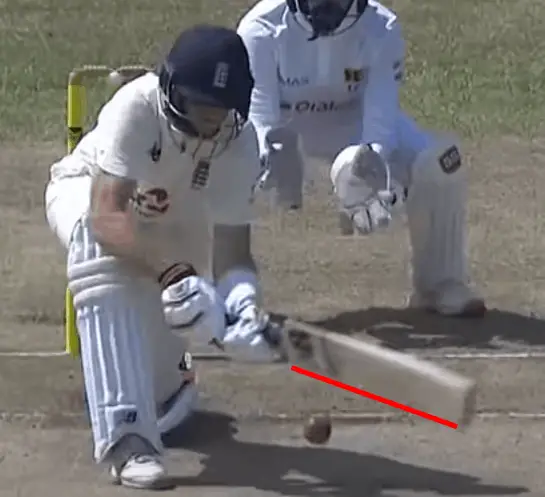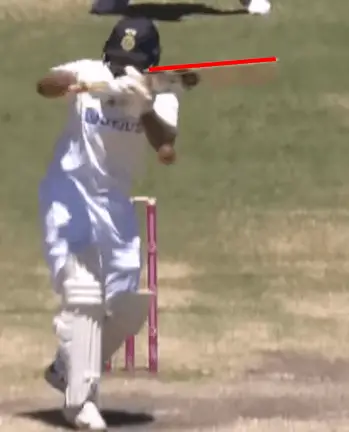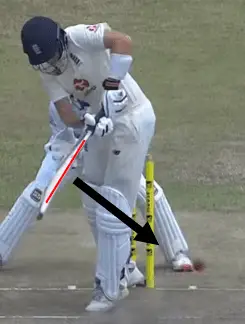As a batsman in cricket there are a number of different ways in which bowlers will try to target you. Some will try to swing the ball back in towards you and hit your pads in the hope you’ll be given out LBW. Some will try to bowl sharp bouncers at you in the hope that you’ll fend the ball off and get caught at short leg, or hook the ball in the air to the deep square leg fielder. Although these two methods of attack are seen frequently in cricket, there’s one that I haven’t mentioned! The vast majority of bowlers will be trying to bowl in a way that forces the batsman to ‘edge’ the ball. If you’re not sure an edge is, or if you’re wondering what the different types of edges are, then this is the post you need to read!
So, what is an edge in cricket?
An ‘edge’ in cricket is the word used to describe what happens when the ball hits the outer part of the batsman’s bat. If a batsman ‘edges’ the ball, it is likely that this will present a wicket taking opportunity to the bowling team. There are five different types of edge that are generally referred to in cricket; outside edge, inside edge, bottom edge, top edge & leading edge.
In the sections below, I’ll take you through each of the different types of edge and explain how bowlers will be trying to target them!
What Is An Outside Edge?
An outside edge is the most common type of edge that is seen in cricket matches. Outside edges occur when the batsman is playing with a pretty straight bat, like the one seen in the picture below. The ‘outside edge’ of the bat is the one furthest away from the batsman’s body, and it is shown by the red line in the picture below. If the ball hits this part of the bat at a decent pace while the batsman is pushing at the ball, there is a good chance that the ball will fly off the edge and travel in the direction of the wicketkeeper or the slip fielders.

A thin outside edge only makes a slight contact with the bat and therefore the flight path of the ball isn’t affected that much. This means that the ball is more likely to travel through to the wicketkeeper. A thicker outside edge connects with a little more of the bat, thus affecting the flight path of the ball a little more. Thick outside edges are therefore more likely to travel in the direction of the slips or gully fielders!
Bowlers will usually be trying to swing the ball away from the batsman in order to find the outside edge. By doing this, they hope that the batsman will be tempted into a shot and will misjudge the line of the ball due to the away swing! This misjudgement of the line could cause them to get an outside edge on the ball which will travel towards the keeper/slips.
If you want to see a video of a typical outside edge dismissal, click this link!
What Is An Inside Edge?
Inside edges are also very common in cricket, and as you’ve probably guessed, they’re the opposite to an outside edge. Inside edges also occur when the batsman is playing with a pretty straight bat, but this time the ball hits the edge of the bat that is closest to the body of the batsman. The inside edge of the bat for a right handed batsman is highlighted in red in the picture below!

If the ball hits the inside edge, a number of things could happen. A thin inside edge may cause the ball to travel through to the wicketkeeper, resulting in the batsman being given out caught. Although this happens less frequently than an outside edge to the keeper, you’ll still see it in a lot of cricket matches! Inside edges can also go straight onto the stumps, which is one of the most frustrating ways for a batsman to get out! Lastly, some inside edges could go directly to a fielder positioned at short leg (click here if you’re not sure where that is), especially when spin bowlers are bowling! Many spinners aim to get the batsman prodding forward defensively with their bat in the hope that they will misread the spin and inside edge the ball to a fielder that is positioned close to the bat – it’s something that all spin bowlers should be targeting!
If you’d like to see a video of a classic inside edge dismissal, click here!
What Is A Bottom Edge?
A bottom edge is as simple as it sounds! It occurs when the ball hits the edge of the bat that is closest to the ground. Bottom edges usually happen when the batsman misjudges the bounce when playing a cross batted shot such as the sweep or the pull. If they think the ball is going to bounce at a certain height and then it keeps low, there is a chance that it could make contact with the bottom edge.

Bottom edges aren’t as dangerous as some of the other types of edges because when the ball hits the bottom of the bat it is going to be deflected towards the ground rather than up in the air! This means there’s less chance of you being caught – even though you’ve miscued your shot. Having said that, there’s always a chance that when bottom edging an attempted hook shot the ball could still travel through to the wicketkeeper, resulting in you being given out caught behind. Additionally, there are some rare cases where a batsman playing a sweep shot might bottom edge the ball directly on to their boot and it will pop up to a fielder that is standing close to the bat! Although this hardly ever happens, it is one of the risks of bottom edging the ball when batting against a spinner.
If you want to see a video of a dismissal via the bottom edge of the bat, click here!
What Is A Top Edge?
Top edges are the opposite of a bottom edge, and they occur when the ball hits the edge of the bat which is the furthest away from the ground. If you look at the picture of Rishabh Pant playing the hook shot below, a top edge would come off the side of the bat highlighted in red, given that it is the side furthest away from the ground. Top edges happen when the ball bounces slightly more than the batsman expects and will usually lead to the ball flying up in the air, potentially offering a catch to a waiting fielder.

When bowlers go into short ball mode and decide to pepper the batsman with a barrage of bouncers, it’s common to see a few top edges here and there. This is exactly the kind of misjudgement the bowler will be trying to force the batsman into! Usually, the will have a couple of fielders behind square on the leg side boundary in order to take advantage of any top edges that travel a long way. The wicketkeeper and the other close fielders will be on hand to snap up any top edges that go directly up in the air!
What Is A Leading Edge?
Leading edges are probably the strangest of all the different types of edge in cricket, because it’s not immediately obvious from the name what edge of the bat the ball hits!
Well, allow me to clear up the confusion! A leading edge occurs when the ball hits the front edge of the bat, rather than the face of the bat. This may sound a little strange when you first read it! But allow me to explain in more detail with an example.

Take a look at the picture above. Joe Root is attempting to hit the ball into the leg side, towards the mid-wicket/square leg area. You can see that the face of the bat is pointing towards mid-wicket/square leg, which means the front edge of the bat is now the edge that I’ve highlighted in red. Now, let’s assume that the batsman mistimes their shot slightly and rather than making contact with the face of the bat, the ball hits the front edge. This is referred to as a leading edge, and when this happens the ball will usually travel down the wicket in the opposite direction to the intended hitting zone! So, a ball that was meant to be hit through mid-wicket in the direction of the black arrow will probably end up travelling straight down the wicket or towards the off side in an area like cover or mid-off.
Conversely, if a batsman was attempting to play a cover drive and got a leading edge, the ball could pop up somewhere between the bowler and mid-wicket.
Conclusion
I hope this post has helped you understand what an edge is and what the different types are! If you watch cricket for a decent period of time, you’ll hear a lot about how the bowlers are trying to hit the edge of the batsman’s bat – it’s a huge part of the game!
If you’re a bowler and you want to be able to make the batsman edge the ball more regularly, you should probably be learning how to swing the ball. Fortunately, I have a very detailed post which will teach you all about that – you can read it by clicking this link! Good luck!
